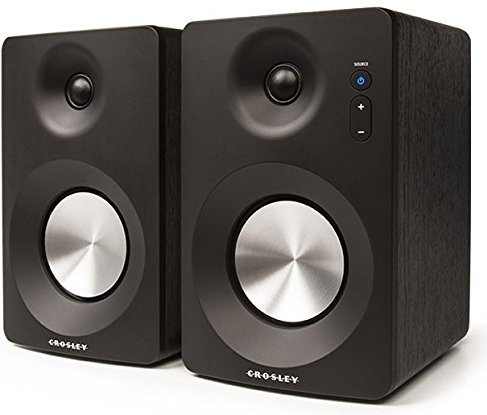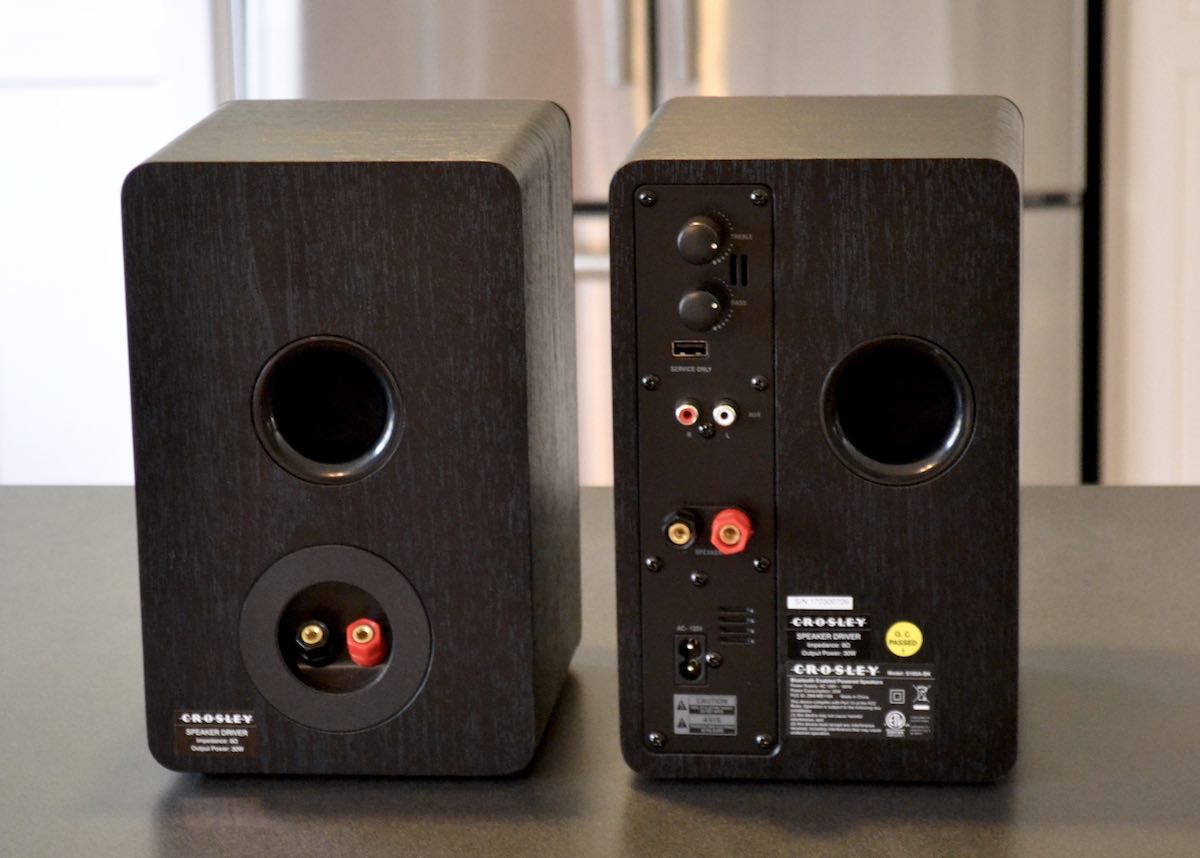Mixing turntables and wireless streaming has become an issue for many people as analog technology makes a resurgence and collides with our digital world. A few weeks back, I reviewed 808 Audio’s Wireless Streaming Turntable, a solution for playing vinyl record audio through a Bluetooth speaker.

That’s one approach for dealing with the problem. Crosley—the company that makes a big chunk of those turntables that are spinning the vinyl—has another approach. Crosley recently released the S100 Stereo Powered Speakers with Bluetooth and auxiliary input.
Crosley S100 Key Specs
• 4-inch woofer
• 1-inch tweeter
• Class D amplifier rated at 15 watts per channel (30 watts total)
• Frequency response 50 Hz to 20,000 kHz
• Bluetooth-ready
• AUX input (stereo RCA)
• Bass, treble and volume controls
• Speaker wire and RCA to 3.5mm cable included
• 9.5 x 7 x 6-inches, total weight 9 pounds
Appearance and Setup

The Crosley S100 speakers are modern looking, with a slightly curved matte black front and exposed drivers. The case is finished in a black faux wood. The woofer’s aluminum finish nicely complements the black. Both speakers have a silver Crosley logo on the front and the primary speaker has an LED-lit audio source/power button and volume control buttons. Overall, it’s a nice modern look, although the logo messes that up a bit.
At the back, both speakers have a bass port and gold binding post-style connections for speaker wire. The primary speaker also has a power connection, stereo RCA Auxiliary input, a USB port (for service only), and separate bass and treble adjustment knobs.
Included in the box is roughly six feet of speaker wire—enough for stereo separation (you can always buy more if want the speakers further apart) and a stereo RCA to 3.5mm cable. That cable is handy because many external sources now use 3.5mm output.
Setting the speakers up is a matter of connecting them with the speaker wire and plugging the primary speaker into a power outlet. To connect an external device, you plug into the AUX input. For Bluetooth, cycle the source button to Bluetooth then use Bluetooth on your device like you would with any wireless speaker.
Things to take into account during setup include speaker placement and if you are connecting a turntable, it needs to have its own integrated pre-amp (or else you’ll need to daisy chain through a pre-amplifier first).
S100 Listening Results
I’m going to preface this with a disclaimer. Primarily that the sound you get out of the S100 speakers is hugely influenced by the way you place them, and by your adjustments to the bass and treble.
To start with, the 30 watts of combined amplification made them plenty loud enough for my office. However, in a larger room, they aren’t quite as effective and don’t project as well as dedicated speakers typically would. As volume neared maximum, the sound became noticeably processed and harsh—but when I was sitting a dozen feet from the S100s, having the volume at midpoint was more than enough.
Going back to placement, the distance between speakers is going to significantly affect the stereo imaging, and so is their height. At head level and six feet apart, the effect was excellent and makes a big case for the S100s over a Bluetooth speaker for your primary way of listening to music. But if you sit off center, place them too close together, or have them too close to the floor, the speakers aren’t delivering their optimal performance.
Overall, I found the bass response was better than expected. Still not up to subwoofer levels, but better than you’ll get from most Bluetooth speakers. The midrange was also good, with the highs tending just a bit on the tinny side. The overall effect is energetic and bright, but you can modify this with the bass and treble adjustments. That can quickly make the sound muddy or harsh if you don’t use a light hand.
I spent several days with the Crosley S100s playing in the background during the day and I threw a variety of musical genres and styles at them. Generally speaking, they did great with guitars and vocals. I put on some Gordon Lightfoot, and his folk-rock approach played well to the S100’s strengths. So did a playthrough of Depeche Mode’s catalog. The speakers had a little more trouble with busy productions. For example, Rush’s “Red Sector A” from the Clockwork Angels Tour soundtrack—live and with a string accompaniment—was a little muddled, with the strings sometimes getting lost in the mix. Turn this track up much past the halfway volume mark and it got harsh, fast.

Naturally, I hooked up a turntable as well. The audio you get is going to be highly dependent on the turntable’s capabilities, but the Crosley S100s did the job quite nicely. If you don’t have a component stereo to plug into and your turntable has a pre-amp, these self-powered speakers are a nice solution for enjoying your records without the compromises of Bluetooth, including the warmth lost when compressing the audio to Bluetooth and the (likely) lack of stereo playback.
Speaking of Bluetooth… Range seemed fine to me, and I could wander into the next room or down the stairs with my iPhone and the connection stayed solid. There was no noticeable hiss during quiet music or pauses, something that can be an issue with some wireless Bluetooth speakers.
Recommendation
Crosley’s S100 speakers don’t replace a portable Bluetooth speaker. You’ll still need one of those if you plan to move your music from room to room. All of the functionality of a self-powered speaker system like this can be had (with much better results) with a receiver or amplifier with Bluetooth support and a pair of bookshelf speakers.
So, what’s the point?
The S100 speakers eliminate the need for that component receiver because they have a built-in amplifier. That saves considerable space. It’s also going to be significantly less expensive, and the speakers themselves are more compact than many bookshelf speakers. Those of you juggling the turntable/Bluetooth speaker issue should take note that the sound the S100s offer is considerably better than you’ll get by plugging a self-amplified turntable into a Bluetooth speaker’s AUX input—especially the stereo capability.
If a turntable isn’t your thing, these can also be used with other devices that can output analog audio, such as a PC.
The price of the Crosley S100 speakers is $189.95, which is about mid-range for powered speakers with Bluetooth capability and puts them in competition with the likes of the more powerful Edifer R1700BTs…
However, at time of writing, they were available on Amazon for $133. That’s less than a decent Bluetooth speaker and makes the Crosley S100 speakers well worth considering if you’re looking for a compact stereo audio solution that can handle both your turntable and Bluetooth streaming music.
Disclosure: Crosley provided a sample S100 speaker system but had no input into this review.



